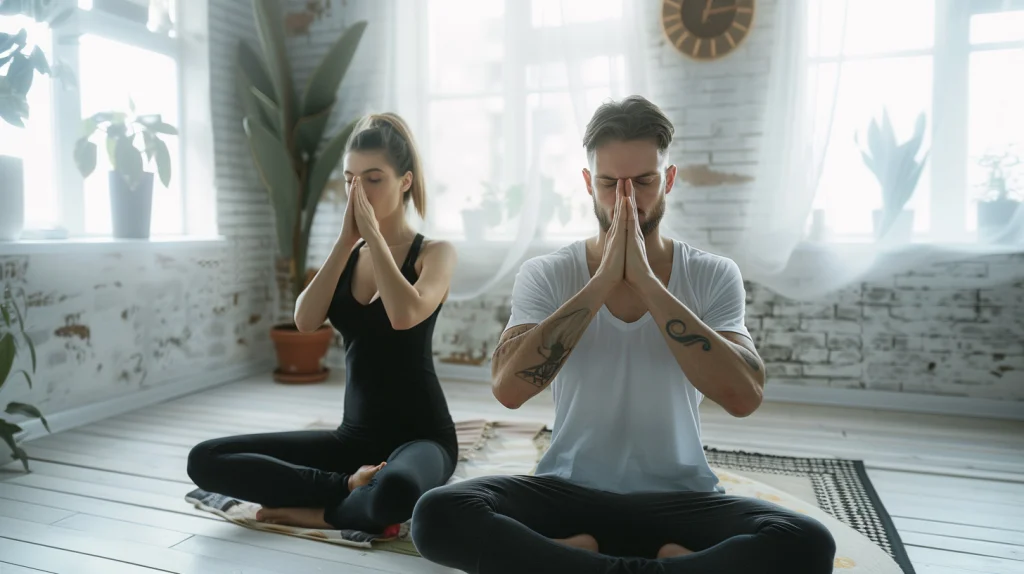4 mins read
Have you ever felt overwhelmed by the sound of your own breath, causing anxiety and discomfort instead of tranquility? You’re not alone. Many of us have experienced moments where our breath becomes a source of unease rather than peace. But what if I told you that your breath could be a powerful tool for inner peace and well-being? Welcome to the world of mindful breathing.
Unveiling the Power of Each Breath: An Introduction to Mindful Breathing
In our hectic lives, we often overlook the significance of something as simple as breathing. Yet, each day, we take about 20,000 breaths, most automatic and unnoticed. Most of the time, we breathe shallow breaths through our nose or mouth.
This is normal breathing.
Mindfulness breathing activities are about paying attention to the sensation of the breath coming in and out of the body. This means noticing the breath, how and where you feel it in the body without trying to change it.
Mindful breathing is a deep breathing exercise. Deep breathing uses big breaths and controls the length. This is to achieve a desired outcome, like falling asleep or reaching a state of relaxation while in meditation or hypnosis.
Mindful breathing teaches core mindfulness. Using meditation breathing techniques like breathing for mindfulness can result in several proven health benefits.
More Than Just Deep Breaths
Mindful breathing goes beyond mere inhalation and exhalation; it’s about cultivating conscious breathing, being aware of each breath’s sensation as it flows through our body. By observing the rise and fall of our chest or belly without judgment, we initiate a journey towards profound self-awareness and emotional regulation.
This practice offers a multitude of benefits:
- Reduced stress and anxiety: By anchoring our attention to the breath, we detach from intrusive thoughts, fostering a sense of tranquility.
- Improved pain management: Observing pain with detachment can diminish its intensity, offering relief and comfort.
- Enhanced emotional regulation: Mindful breathing techniques empower us to navigate emotions with clarity and compassion.
- Sharpened focus and cognitive function: Heightened awareness of the breath enhances concentration and mental acuity.
- Deeper sleep: Practicing breathing meditation for sleep can provide a calm mind and body, improving the quality and duration of sleep.
- Greater self-compassion: We cultivate empathy towards ourselves and others by nurturing inner awareness.

Why Does Mindful Breathing Work? The Science Behind the Sensation
Mindful breathing isn’t just a spiritual practice; it’s rooted in science. Studies reveal that focusing on the breath activates the parasympathetic nervous system, inducing relaxation and counteracting stress responses.
Moreover, it modulates brainwave activity, transitioning from Beta (associated with alertness and busy thinking) to Alpha waves (linked to calmness and focused attention). This shift in brain activity contributes to the numerous benefits experienced by regular practitioners.
Exploring Different Types of Mindful Breathing Techniques
Diverse techniques cater to individual preferences and needs:
- Counting breaths: Gently count each inhale and exhale to anchor your attention.
- Focusing on sensation: Tune into the rise and fall of your chest or belly, embracing the rhythm of your breath.
- Transition awareness: Notice the subtle shift from inhalation to exhalation, fostering mindfulness in transitions.
- Alternate nostril breathing: Engage in this practice to achieve mind balance and promote energy and harmony within yourself.
- Observing breath quality: Pay attention to breath length, depth, and temperature, embracing conscious breathing.

Embarking on Your Mindful Breathing Journey: A Guided Meditation
Now, let’s put theory into practice. Find a quiet, comfortable space, set a timer for 10-15 minutes, and follow these steps:
- Settle into your position: Sit with your back straight or lie down comfortably. Close your eyes (optional) or focus on a point in the room.
- Ground yourself: Notice the sensations in your body, the temperature around you, and any sounds nearby.
- Bring your attention to your breath: Feel the air entering and leaving your nostrils, or the rise and fall of your chest or belly.
- Choose your anchor: Select one of the breathing techniques mentioned above and gently guide your attention back to it if it wanders.
- Observe with curiosity: Don’t judge your thoughts or feelings. Simply observe them with a gentle, accepting awareness.
- Let go and return: When the timer goes off, slowly wiggle your fingers and toes, then gently open your eyes (if closed).
Mindful breathing goes beyond mere inhalation and exhalation; it’s about cultivating conscious breathing, being aware of each breath’s sensation as it flows through our body
Remember, Practice Makes Progress: Embracing the Journey
Be kind to yourself as you learn. It’s natural for your mind to wander – simply redirect your attention back to your breath with a smile. Each breath is an opportunity to reconnect with your inner self and cultivate peace amidst life’s uncertainties.
In moments where anxiety arises, remember that you’re not alone. Many individuals, like myself, have grappled with breath-related anxiety. However, by acknowledging our challenges and embracing them with courage, we pave the way for growth and resilience.
So, as you continue your exploration of mindful breathing, know that every inhalation and exhalation carries the potential for transformation and inner peace. Start your journey today, and let the rhythm of your breath guide you towards a life of serenity and fulfillment.
FAQs
Mindful breathing is a popular technique for managing anxiety, but it’s not a magic bullet. While it works wonders for many, some individuals find it amplifies their anxiety.
Focusing on your breath when you already have anxiety around it can turn mindfulness into a trigger, leading to hyperventilation and worsening anxiety.
If mindful breathing isn’t clicking, try other options like progressive muscle relaxation or cognitive behavioral therapy. We’ll explore more options in future articles.
Practice mindfulness for at least five minutes daily for a week or more to experience the benefits.
Exhaling through your mouth removes more carbon dioxide from your body, which is why people believe it reduces the feeling of air hunger. However, if you breathe in and out through your nose while exercising, you will gradually become less sensitive to air hunger over time. This will lead to an improvement in your breathing efficiency, which will delay the feeling of breathlessness.
